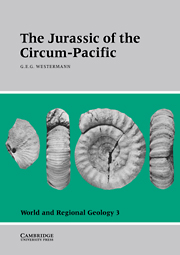Book contents
- Frontmatter
- Contents
- List of contributors
- Preface
- Acknowledgments
- Introduction
- Part I Time scales
- Part II Circum-Pacific base map
- Part III Regional geology and stratigraphy
- Part IV Biochronology
- 12 Ammonite zones of the circum-Pacific region
- 13 Jurassic palynomorphs of the circum-Pacific region
- 14 Radiolarian biozones of North America and Japan
- 15 Ostracods of western Canada
- 16 Bivalve zones and assemblages of the circum-Pacific region
- 17 Belemnites of the southwest Pacific
- Part V Biogeography
- Part VI Climatology and oceanography
- Appendix: Biochronology and atlas with index and guide fossils
- General Index
- Index of Guide- and Indexfossils
17 - Belemnites of the southwest Pacific
Published online by Cambridge University Press: 04 August 2010
- Frontmatter
- Contents
- List of contributors
- Preface
- Acknowledgments
- Introduction
- Part I Time scales
- Part II Circum-Pacific base map
- Part III Regional geology and stratigraphy
- Part IV Biochronology
- 12 Ammonite zones of the circum-Pacific region
- 13 Jurassic palynomorphs of the circum-Pacific region
- 14 Radiolarian biozones of North America and Japan
- 15 Ostracods of western Canada
- 16 Bivalve zones and assemblages of the circum-Pacific region
- 17 Belemnites of the southwest Pacific
- Part V Biogeography
- Part VI Climatology and oceanography
- Appendix: Biochronology and atlas with index and guide fossils
- General Index
- Index of Guide- and Indexfossils
Summary
Belemnitida are straigraphically useful within the southwest Pacific region both for local correlation and for testing hypotheses on interregional correlations.
Indonesia and Papua New Guinea
Several genera and species, all members of the suborder Belemnopseina Jeletzky, have been recognized widely within eastern Indonesia and Papua New Guinea (Kruizinga 1920; Stolley 1929; Stevens 1965; Challinor and Skwarko 1982; Challinor 1991), and zones based on them have regional significance. Easily recognized, partly overlapping assemblages (Figure 17.1) characterized either by their dominant genera (assemblages 1 and 3) or by genera absent or poorly reperesented in other intervals (assemblage 2) are as follows:
Dicoelites–Conodicoelites assemblage (late Bajocian–early Oxfordian); Belemnopsis is common in the Callovian- Oxfordian
Hibolithes assemblage (late Callovian–latest Oxfordian); Belemnopsis present throughout
Belemnopsis assemblage (basal Oxfordian–latest Tithonian) equivalent to the range of the moluccana lineage (Challinor 1991); scattered Hibolithes are present in the Tithonian
Only assemblages 1 and 3 have thus far been recognized in Papua New Guinea.
Closer correlation may be achieved utilizing individual species. The Callovian Dicoelites is distinctive and has been recognized at other localities in eastern Indonesia (Challinor 1991). Early Oxfordian to late Tithonian Belemnopsis of the moluccana lineage are widely distributed (Challinor 1989) and form an evolving group whose species are useful for closer correlation. Interspecific changes allow more precise correla- tion than can be attained by using individual species (Challinor 1989).
New Zealand
Local stages are used in New Zealand, and problems in correlation with international stages exist, particularly in the Late Jurassic.
- Type
- Chapter
- Information
- The Jurassic of the Circum-Pacific , pp. 308 - 310Publisher: Cambridge University PressPrint publication year: 1993

